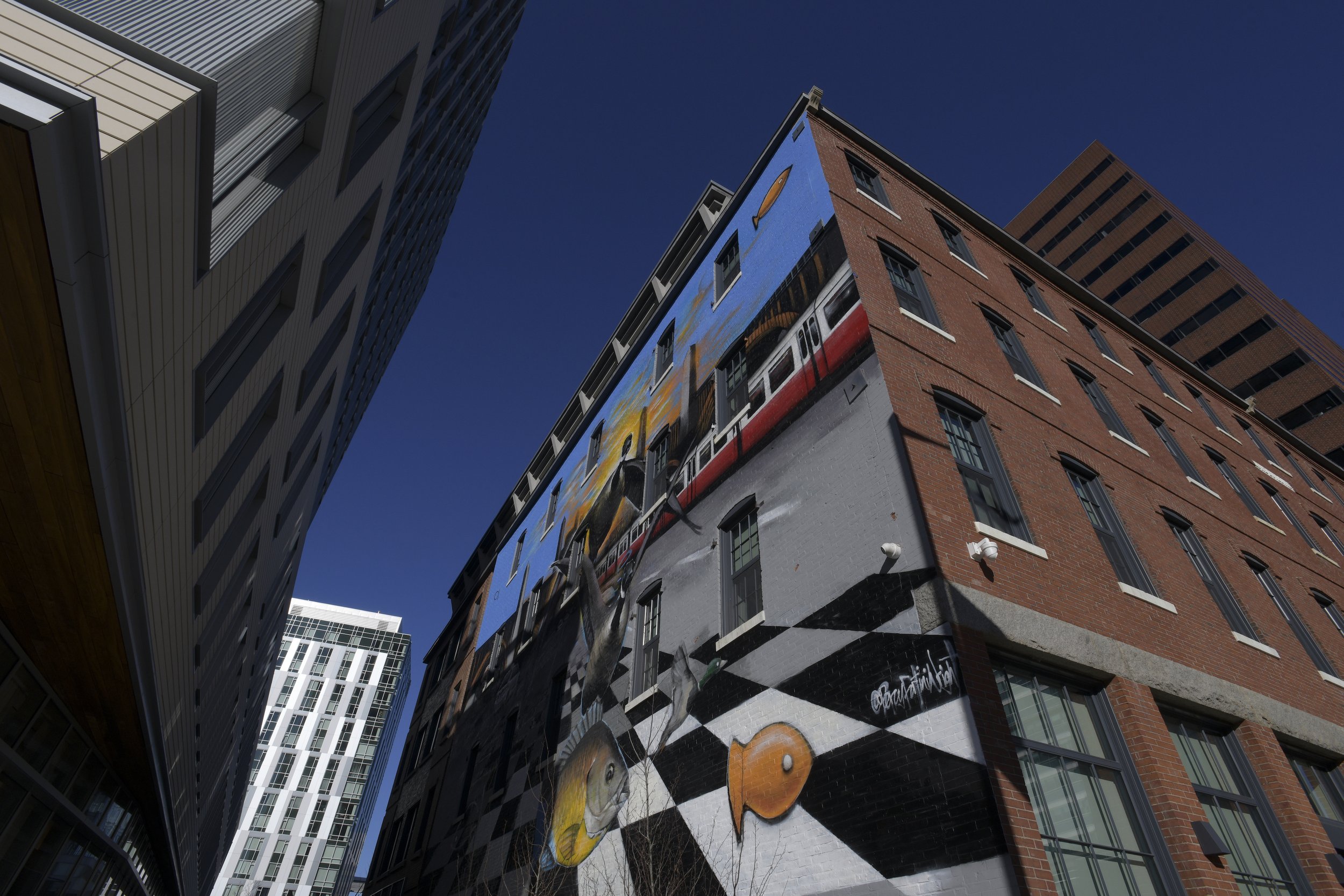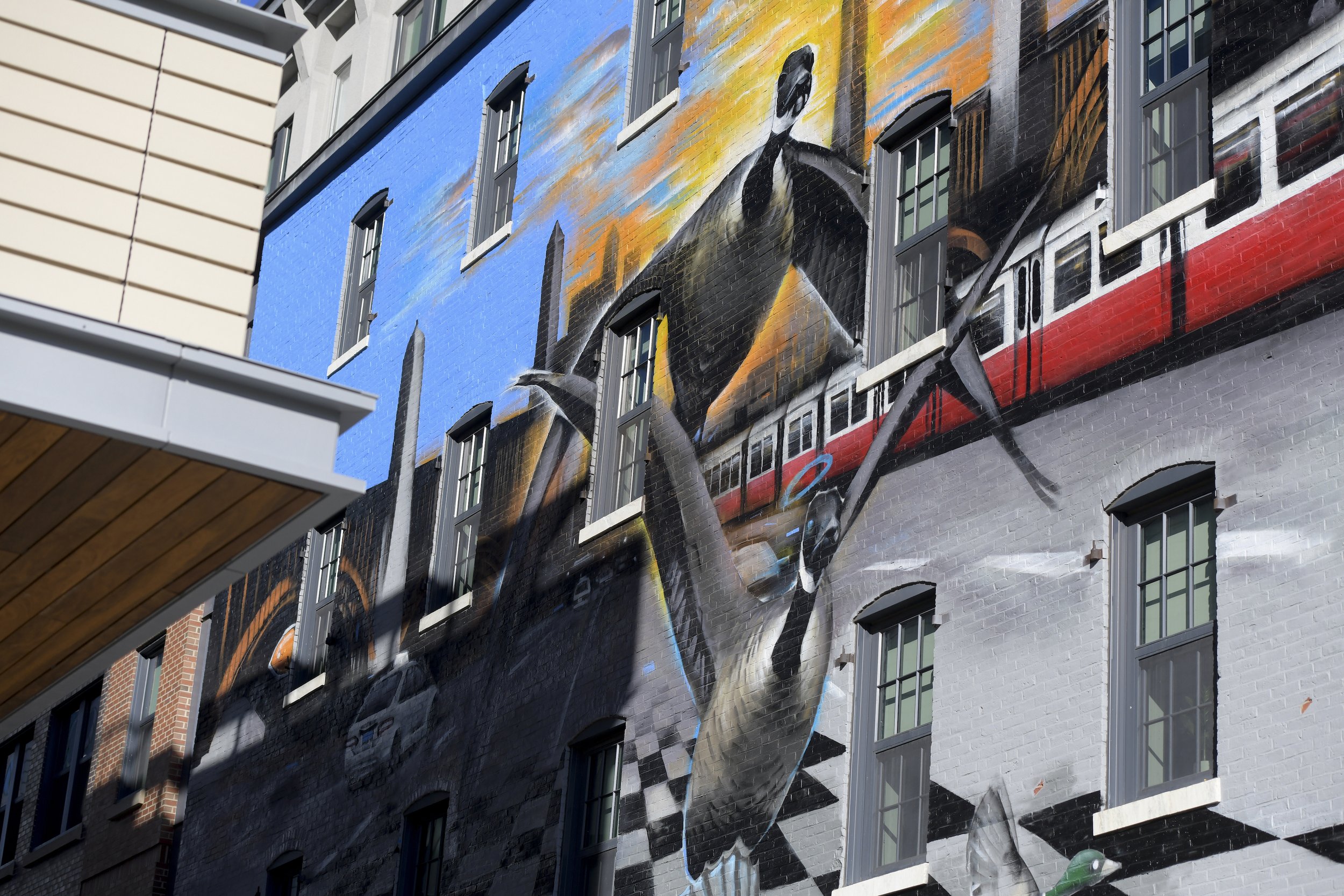N+T Communications Assistant Blu recently touched base with local artist and muralist Percy Fortini-Wright. This interview explores his practice and latest mural, Charlesgate, at 139 Main Street, Kendall Square, Cambridge, commissioned by MIT Investment Management Company’s Kendall Square Public Arts Initiative and curated by Now + There.
B: What are your thoughts on public art? Tell us about your art experiences then vs. now (in Boston + across different spaces you have covered)
P: Today, Public Art is more organized. After Wynwood in Miami, we started seeing more public art. Before, most murals were by individual. They embraced being daring and thrived in the underground world/culture, to share their creativity in unique ways. At this current moment, art serves as an infrastructure for development.
We are employing Public Art to beautify cities, give a new face. Overall, there seems to be more engagement between the art world and public manifestations of art. This new (or perhaps refreshed relationship) makes public art more socially acceptable.
Though I understand the importance (and implications) of engaging in socially acceptable practices, I do not care about murals or public art receiving social acceptance. I support this movement, yet I wonder about gentrification and its repercussions on existing and future communities.
B: Oh, Sure. Of course! Do you feel that social acceptance is necessary for this kind of work?
Details from Charles Gate.
P: Yes and no. I do not care, personally, but I think there are parts of social acceptance that matter. Ultimately people have to eat and make money off their work, so the more art that gets done in a particular area, the more visibility and access. This art is for me first, the public second. I look at my work as teaching moments.
B: Totally! You mention working in public/private spaces, exterior/interior spaces, and moving across local/national or global landscapes. I feel curious about one or two lessons you have learned from moving between these spaces.
P: I almost look at it as a breath, with the interior breath/inhale and the exterior breath/exhale. With art and anything you breathe the world in and out. This exchange infuses experiences and perspectives down to what you create. With the inhales, I take what I have learned from the public sphere into the home, into that chosen space. And, the exterior is kind of like when you are taking what is within you or in that inhale and pushing it outwards (back at the world and into other things) in the public space, that is no longer as intimate and personal. I love that my work is very metaphysical in its concoction.
B: I love that.
P: The challenges that arise have to do with that act (of balancing personal and collective or intimate and public). Will the onlooker take it in and digest it? Is the perspective relatable to the exterior world? Are people going to appreciate what they see/feel? Are they practicing vulnerability when you expose yourself for them to see? You have to deal with the environment too. Rain, sleet, gates? These factors (or design elements, if you will) affect how people see and respond to the art. Access remains a site of tension. Many (natural/abstract/metaphysical) elements act and co-exist with the work. With the interior, you have a little bit more personal and intimate, quiet, possibly, and with the exterior space it can be a little bit louder and more exposed physically.
B: Earlier, you mentioned making your art for yourself first and the public second. What are you attempting to do with the motifs and marks we find in your work?
P: I see my marks or my signature as the genetic imprint of my creativity. No official document is legal unless someone signs it. So, I look at my work like an official document. It displays the time and effort I put into responding to the world around me. These graffiti tags you see around matter (to me/us) because they represent the genetic traces of our community.
As a muralist, I can read personality based on their signature. This ability comes from being a lover of tagging and feeling/seeing individual style. You can tell much about art and artists when you focus on the details. This art practice (mural/graffiti) is also a full-contact sport. You use your whole body to make large shapes or letters, stretching from one end to another.
B: If you were talking about your recent piece Charles Gate to a six or seven-year-old, what would you say about it?
P: I talk to my son as if he is 20 years old.
B: Wow! How old is he?
P: He's eight.
B: (laughs)
P: Basically, I am a fisherman. I love being near the ocean. I am really into nature and the biodiversity of what has been around. The Charles River contains saltwater and freshwater fish, which most people do not know. My art project connects the river with life/activities in Cambridge, Boston, and in/on the Charles River itself. The bridge is a gateway connecting to water that merges different worlds. The checkerboard motif represents yin and yang, being mixed, and even holding good and bad experiences that we achieve. Growing up, I was called a zebra for being mixed (laughs). You can imagine a referee, that middle point between two opposing forces. Spiritual elements and cultural motifs pop up in the art.
B: Would you like to share anything else about your process?
P: Walking up and down the scaffolding and climbing up things was acrobatic, in a way. The scaffold was very invasive too. We did the work in a short amount of time, and we executed it well. I truly enjoyed using my entire body!
B: Love that. Thank you so much for chatting with me, Percy!
P: Thank you, Blu!
Percy Fortini-Wright is a Boston based artist who received both his BFA and MFA from the Art Institute of Boston at Lesley University. While in his youth he wrote graffiti, most active during the late 1990’s, becoming a technician of wild style graffiti letters, tags and bubble letters while simultaneously he evolved as a traditional painter of scenes, abstraction, and portraiture to his characters the Children from Beyond.
Percy’s website.
Photos by Faith Ninivaggi




